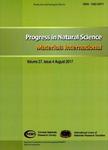Molecular mapping of QTLs for root response to phosphorus deficiency at seedling stage in wheat (Triticum aestivum L.)
Molecular mapping of QTLs for root response to phosphorus deficiency at seedling stage in wheat (Triticum aestivum L.)作者机构:Key Laboratory of Crop Heterosis and Utilization Department of Plant Genetics and Breeding China Agricultural University Beijing 100094 China Key Laboratory of Crop Genomics and Genetic Improvement Department of Plant Genetics and Breeding China Agricultural University Beijing 100094 China Beijing Key Laboratory of Crop Genetic Improvement Department of Plant Genetics and Breeding China Agricultural University Beijing 100094 China
出 版 物:《Progress in Natural Science:Materials International》 (自然科学进展·国际材料(英文))
年 卷 期:2007年第17卷第10期
页 面:1177-1184页
核心收录:
基 金:Supported by National Natural Science Foundation of China (Grant No 30671297)
主 题:QTLs roots wheat seedling RIL P-deficiency.
摘 要:Phosphorus (P) deficiency in the soil is one of the major abiotic stresses that limit plant growth and crop productivity throughout the world. Development of cultivars with improved P-deficiency tolerance is an efficient strategy for sustainable agriculture. Plant roots play an important role in crop growth and development, especially in nutrient uptake and improvement of P-efficiency. Mapping quantitative trait loci (QTLs) for root traits and their response to low P stress at seedling stage will facilitate the development of P-efficient wheat cultivars. In this study, 30 QTLs (LOD2.0) were mapped for the three root traits, such as root length, root number and root dry matter under different P supply conditions and their response to P-stress. These QTLs were distributed on 14 chromosomes, with each of the 5 QTLs explaining more than 10% phenotype variance. Analyses showed that root traits and their response to P-deficiency were controlled by different QTLs. In addition, alleles with positive effects were separated on both parents, and wheat cultivars with improved P-efficiency could be developed by accumulating these positive effect alleles together.



